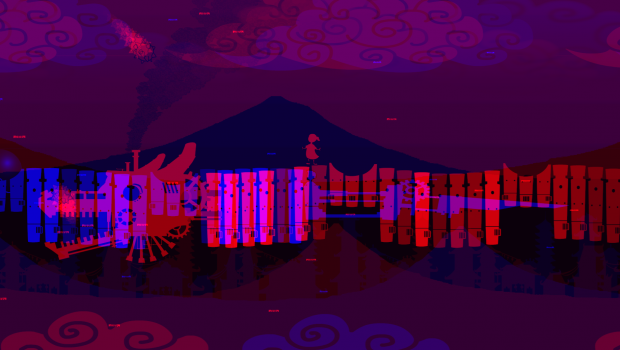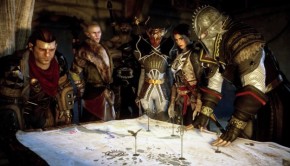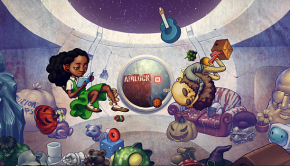Notes From Indiecade: Sunder
Here’s the good news: the further I get from Indiecade, the more I’m convinced that Sunder is the best thing I played there. The concept is audacious enough; co-op 2D platformers are a dime a dozen, but Sunder’s special trick is to show only half of the information onscreen to each player. To make any progress at all, the pair of players in control of the brother and sister onscreen must keep up a steady flow of conversation, describing aloud what they see for the other player’s benefit and coming to a shared understanding of what must be done to proceed. The only visual cue available is a “ping” button which shows the current position of your character, but no other information about their surroundings. When the friend accompanying me to Indiecade and I sat down, our initial fumbling gave way to a steady back-and-forth, until we worked as a team in a way that felt tighter than any co-op game I’d ever experienced before.
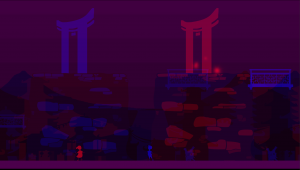 Here’s the bad news: Sunder achieves this effect by painting two simultaneous playfields, one red and one blue, and the special glasses each player wears filters out one color so that they see only half the action. “This game would work over the internet,” acknowledges Nicholas Fuller, one of the game’s designers at Digipen, “but there’s a certain level of interaction you can’t get over voice chat. Later levels in the game promote face-to-face verbal/non-verbal communication. We even have a boss that deliberately attempts to turn the players against each other. These kinds of events works best when you’re sitting next to each other. You can read each other’s body language, talk over the top of one another, and high five when you beat the area.”
Here’s the bad news: Sunder achieves this effect by painting two simultaneous playfields, one red and one blue, and the special glasses each player wears filters out one color so that they see only half the action. “This game would work over the internet,” acknowledges Nicholas Fuller, one of the game’s designers at Digipen, “but there’s a certain level of interaction you can’t get over voice chat. Later levels in the game promote face-to-face verbal/non-verbal communication. We even have a boss that deliberately attempts to turn the players against each other. These kinds of events works best when you’re sitting next to each other. You can read each other’s body language, talk over the top of one another, and high five when you beat the area.”
Worse still, when asked how the average player might acquire a pair of specialized glasses of their own to play the game–which is freely available online–Fuller says, “I wish I could tell you you could hop down a local store and get them, but unfortunately they are only available online and the minimum order is like 200 or so.”
Trust us when we urge you not to let this be an obstacle. Hack together your own pairs from conventional red/blue 3D glasses if you must, but find a way to play this game, because it’s the best co-op romp since Portal 2–which it not coincidentally borrows a design cue or two from. “Portal 2 co-op is probably the closest comparison for this game,” agrees Fuller, “hence it was basically our only source of inspiration and reference. Pinging was implemented after we realized that our student-team art budget would not allow us to produce environments that are distinct enough such that the players could find common reference points. I was a hard decision and we wrestled with the implications for months but in the end it makes the gameplay smoother and, surprisingly, promotes communication in the early levels. Players often have this ‘Ahh!’ moment when they first see the other player’s ping. That’s the point when it all clicks.”
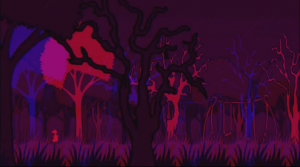 The open dialogue between players isn’t used just for puzzle-solving, but also in the game’s storytelling. Brief interstitial scenes between levels display sentence fragments to each player, which they must read aloud to form the complete sentences that slowly unravel the game’s story. “We really enjoy this kind of short-form storytelling,” says Fuller. “It works great for the tutorials too, as the game conveys two different subsets of information to the players. This encourages them to talk it out. In the end, it’s all about getting the players to communicate. We tested Sunder extensively with pairs of shy strangers and made these icebreaker-esque levels to get the conversation flowing.”
The open dialogue between players isn’t used just for puzzle-solving, but also in the game’s storytelling. Brief interstitial scenes between levels display sentence fragments to each player, which they must read aloud to form the complete sentences that slowly unravel the game’s story. “We really enjoy this kind of short-form storytelling,” says Fuller. “It works great for the tutorials too, as the game conveys two different subsets of information to the players. This encourages them to talk it out. In the end, it’s all about getting the players to communicate. We tested Sunder extensively with pairs of shy strangers and made these icebreaker-esque levels to get the conversation flowing.”
“The characters remain nameless,” continued Fuller about the story, “but there is an implicit story that is widely left up to interpretation. The part that was not featured at the IndieCade demo is that the brother and sister, upon pinging, actually talk to each other. They have little quips that characterize their motivations and give some context to the dream worlds that they are traversing.” When asked if the brother and sister’s move set remains identical throughout the game, or if some degree of differentiation is eventually introduced, Fuller says, “It was definitely tempting to differentiate the two. We fiddled with the idea but in the end we decided that having the two players be of equal ability helped foster a degree of cooperation. You know your own ability and your partner’s, there’s no gimmick–just the siblings and the world.”
Fuller and his team did a lot with those simple abilities, and what we played at Indiecade continued to surprise. There were the usual challenges you’d expect from a game like this–have one player push a block so that the other player can use it as a stepping stone over an obstacle–but they were given fresh life by the fact that neither player can see the other’s “screen.” Moreover, it isn’t long before the challenges get inventive, like the hilarious room that requires a coordinated effort to play a simple game of Pong to proceed.
It’s a bit heartbreaking to be so excited about a game with such tall barriers to entry, we won’t deny. But if you manage to wangle attendance to GDC next year, Fuller expects to be set up there, and has high hopes for next year’s IGF as well. And even if you can’t, don’t let a little bit of colored cellophane stop you from this beautiful, thoughtful game. Display some adaptability (and show us your most creative solutions while you’re at it). You won’t regret it.

